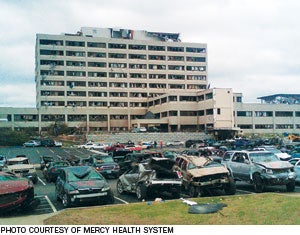St. John's begins to rise from the rubble
 |
| The force of the tornado that hit St. John's Regional Medical Center is evident from the damage to the building and cars in the parking lot. |
In all, 153 died and more than 900 were injured, making it the deadliest tornado in the United States since 1947.
Plans call for a new permanent acute care hospital to be built on an undetermined site in Joplin, with groundbreaking scheduled for January 2012, says Cora Scott, spokeswoman for St. John's. Construction is expected to take a couple of years.
Sisters of Mercy Health System, which owns the hospital, decided to build a new facility after building engineers determined the original 370-bed medical center was not salvageable. All windows were blown out of the hospital and entire sections of the facility's nine floors were destroyed. Parts of the hospital's facade and roof were ripped off along with sections of the top two floors.
In the meantime, Mercy plans to build a temporary modular-type hospital within the next six months in Joplin to replace a temporary 60-bed mobile facility, Scott says. The mobile unit is a tent-like structure that can withstand 100 mile-per-hour winds and offers full patient services, including emergency care, surgery, imaging and lab work.
After the tornado hit, 183 patients were evacuated from St. John's in about 90 minutes with the help of the estimated 250 staff who were in the hospital at the time, Scott says. Patients were transported to nearby hospitals and triage centers in everything from cars to ambulances to pickup trucks. Five patients and one visitor in the hospital died from undetermined causes, she says.
The number of fatalities in the hospital could have been far worse, Scott says. "Looking at the devastation in the community, it's quite astounding that so many people in the hospital survived, and it's a testament to the hospital's structure for sure," Scott says.
Most of the hospital's superstructure — concrete frames, column supports, concrete slabs and beams — are still standing. Bob Norton, vice president of facilities, Mercy, also credits the structure's sturdiness, along with the quick actions of hospital staff who moved patients to safety inside the hospital, for minimizing the number of fatalities.
Even though the medical center's information technology infrastructure was destroyed in the storm, the electronic health record system was up and running in the mobile hospital within 24 hours after the storm, Scott says. Fortunately, the hospital had changed from a paper record system to an electronic system used by other Sisters of Mercy hospitals and clinics just three weeks prior to the storm.




